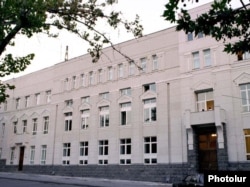The economy of Armenia may be among the latest victims of Russia's invasion of Ukraine.
Thousands of workers at the country's largest textile factory are facing layoffs or wage cuts amid similar fears at other industrial firms and businesses.
The reason? The country's currency, the dram, has risen dramatically in value in recent months, making Armenian exports more expensive and therefore less competitive.
Oddly enough, an influx of Russians fleeing their homeland amid a further clampdown in the wake of the invasion also may be putting pressure on the dram, analysts say.
The Gloria textile plant in the northern city of Vanadzor ships most of the clothing it manufactures to Western Europe, owner Bagrat Darbinian told RFE/RL's Armenian Service.
Due to a drop in exports, Darbinian said he's been forced to cut production costs to compensate for the loss of revenue. He said he has already told the company's workers they would need to accept a 30 percent reduction in their wages or risk being sent on unpaid leave or losing their jobs altogether.
"I am ashamed to walk out on the shop floor," Darbinian said. "People are already not paid much, and I want to cut their wages. But there is no other way out."
Like the Russian ruble, the dram weakened against the U.S. dollar and the euro in the immediate aftermath of the Russian invasion but rallied strongly in the following months.
Shortly after President Vladimir Putin ordered Russian troops into Ukraine on February 24, the ruble began a steep dive, reaching at one point a record low of about 135 to the U.S. dollar.
The West froze about half of Russia's $600 billion foreign currency reserves. Some 1,000 Western companies have since suspended or pulled out stakes in the country, and Russia has been banned from buying key Western technology and services.
However, Russia's currency has proved resilient. After plummeting, the ruble has since rebounded, becoming one of the world's best performing currencies, according to Reuters.
The ruble has been bolstered by capital controls aimed at forcing businesses and investors to buy the Russian currency and soaring global energy prices, allowing the Kremlin to use the proceeds of oil and gas sales to prop up the ruble.
In Armenia, since the outbreak of the war, the dram has strengthened by 13 percent against the dollar and 22 percent against the euro.
Experts put this down to the relative macroeconomic stability in Russia, Armenia's No. 1 trading partner. Ties go beyond the economic sphere. Armenia is Russia's strategic ally in the South Caucasus region and hosts a Russian military base, as well as being part of the Russian-led security alliance, the CSTO. Russian troops also maintain a shaky cease-fire after the short war between Azerbaijan and Armenia in 2020 over the disputed territory of Nagorno-Karabakh.
Since Russia launched its unprovoked assault on Ukraine, Armenian Prime Minister Nikol Pashinian's government has tried to walk a fine line between neutrality and tacit loyalty to Putin.
The creeping rise in the value of the dram is prompting growing concerns from Armenian companies oriented toward Western and other non-Russian markets.
Darbinian, who said he has invested $5 million in the Gloria factory in the last three years, said he has already appealed to Armenia's government and the central bank to help weaken the dram.
He is not alone. Similar appeals have been made by other export-oriented entrepreneurs and businesses, notably representatives of Armenian software companies, RFE/RL's Armenian Service reports.
Martin Galstian, the country's central bank governor, made clear on June 12 that the bank will not cut interest rates or intervene in the domestic currency market to cool down the dram. Galstian said that the stronger dram is somewhat easing inflationary pressures on the Armenian economy aggravated by the Ukraine war.
"By artificially weakening the dram, we would create an even worse inflationary situation that would hit all citizens, including exporters," he told reporters.
Galstian also argued that the stronger dram is making many imported raw materials cheaper for exporters.
As Galstian's comments suggest, a stronger dram is not all bad news.
Narek Karapetian, a Yerevan-based economist, suggested that the stronger dram will help to curb rising inflation in Armenia.
"This is a major development that will definitely have an impact on consumer prices," Karapetian told RFE/RL's Armenian Service.
The Armenian government's Statistical Committee recorded an annual inflation rate of 8.4 percent in April, up from 7.4 percent in March. According to the committee, food prices in the country rose by an average of 12.1 percent in the first quarter of this year.
Russians who have fled to Armenia may also be bumping up the value of the dram, analysts say. Since the invasion of Ukraine, an estimated 108,000 Russian citizens have arrived in Armenia.
With European destinations closed to Russian airlines, there are few options left. Armenia requires no entry visas, and there are regular flights to Yerevan from Moscow.
According to Armenian authorities, about 27,000 foreigners, most of them Russian citizens, opened Armenian bank accounts between February 24 and the end of March. Also, some Russian tech companies reportedly relocated their personnel to the South Caucasus country to evade Western sanctions.
Russian professionals are particularly interested in the IT sector in Armenia, said Hayk Chobanian, executive director of the Union of Advanced Technology Enterprises, in comments made in March.



